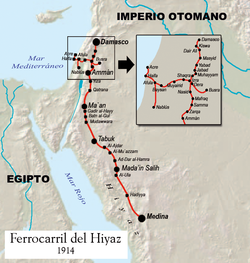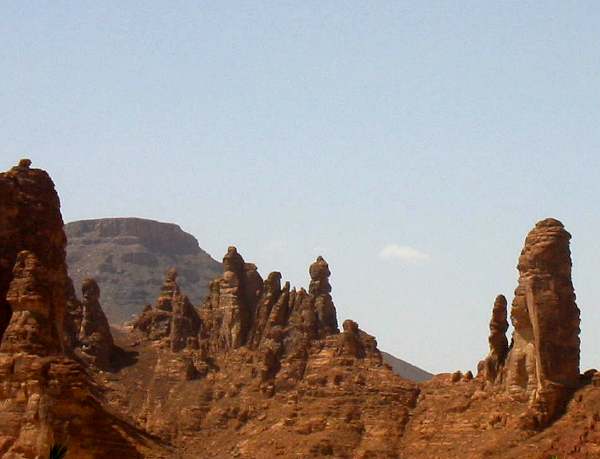 Mecca, also spelled Makkah (in full: Makkah Al-Mukarramah; Arabic: مكّة المكرمة) is Islam's holiest city and home to the Kaaba shrine and the Grand Mosque. The city is known for the annual Hajj pilgrimage, which being one of the five pillars of Islam, attracts more than 2 million pilgrims.
Mecca, also spelled Makkah (in full: Makkah Al-Mukarramah; Arabic: مكّة المكرمة) is Islam's holiest city and home to the Kaaba shrine and the Grand Mosque. The city is known for the annual Hajj pilgrimage, which being one of the five pillars of Islam, attracts more than 2 million pilgrims.Mecca in 1953

The modern day city is located in and the capital of Saudi Arabia's Makkah Province, in the historic Hejaz region. With a population of 1,700,000 (2008), the city is located 73 kilometres (45 miles) inland from Jeddah, in a narrow valley, and 277 metres (910 ft) above sea level.
Early history
According to Islamic tradition, the history of Mecca goes back to Ibrahim (ابراهيم, Abraham) when he built the Kaaba with the help of his son Ismā'īl (اسماعيل, Ishmael), around 2000 BC. The inhabitants were stated to have fallen away from monotheism through the influence of the Amelkites.[11] Historians state that the Kaaba later became the repository of 360 idols and tribal gods of all of Arabia's nomadic tribes. Until the 7th century, Mecca's most important god would remain to be Hubal, having been placed there by the ruling Quraysh tribe.[12][13]
The city was also known to Ptolemy as "Macoraba". In the 5th century, the Quraysh tribe took control of Mecca, and became skilled merchants and traders. In the 6th century they joined the lucrative spice trade as well, since battles in other parts of the world were causing trade routes to divert from the dangerous sea routes to the relatively more secure overland routes. The Byzantine Empire had previously controlled the Red Sea, but piracy had been on the increase. Another previous route, that from the Persian Gulf via the Tigris and Euphrates rivers, was also being threatened by exploitation from the Sassanid Empire, as well as being disrupted by the Lakhmids, the Ghassanids, and the Roman-Persian Wars. Mecca's prominence as a trading center surpassed the cities of Petra and Palmyra.[14][15]
By the middle of the 6th century, there were three major settlements in northern Arabia, all along the southwestern coast that borders the Red Sea, in a habitable region between the sea and the great desert to the east. This area, known as the Hejaz, featured three settlements that had grown around oases, where water was available. In the center of the Hejaz was Yathrib, later renamed as Medina. 250 miles (400 km) south of Yathrib was Taif, a mountain town, and northwest of Taif was Mecca. Though the area around Mecca was completely barren, Mecca was the wealthiest and most important of the three settlements. Islamic histories state that it had abundant water via the Zamzam Well, which was the site of the holiest shrine in Arabia, the Kaaba, and was also at the crossroads of major caravan routes.[16]. Actually the well of Zamzam was barely sufficient to support the small community there, the Kaaba was but one of many such Arabian Polytheistic temple found in the peninsula, and the city was the terminus for a single caravan route which ran from Mecca to Syria.[17]
The harsh conditions of the Arabian peninsula usually meant a constant state of conflict between the tribes, but once a year they would declare a truce and converge upon Mecca in an annual pilgrimage. This journey was intended for religious reasons, to pay homage to the shrine, and to drink from the Well of Zamzam. However, it was also the time each year that disputes would be arbitrated, debts would be resolved, and trading would occur at Meccan fairs. These annual events gave the tribes a sense of common identity and made Mecca extremely important throughout the peninsula.[18]
Muhammad's great-grandfather had been the first to equip a camel caravan, and they became a regular part of the town's economy. Alliances were struck between the merchants in Mecca, and the local nomadic tribes, who would bring leather, livestock, and metals which were mined in the local mountains. Caravans would then be loaded up in Mecca, and would take the goods to the cities in Syria and Iraq.[19] Islamic tradition claims that goods from other continents also flowed through Mecca. From Africa and the Far East towards Syria supposedly flowed spices, leather, drugs, cloth, and slaves; and in return Mecca was to have received money, weapons, cereals, and wine, which were distributed throughout Arabia. The Meccans signed treaties with both the Byzantines and the Bedouins, and negotiated safe passage for caravans, which included such things as water and pasture rights. These further increased Mecca's political power as well as economic, and Mecca became the center of a loose confederation of client tribes, which included those of the Banu Tamim. Other forces such as the Abyssinian, Ghassan, and Lakhm were in decline, and Meccan influence was the primary binding force in Arabia in the late 6th century.[18]
Muhammad
Muhammad was born in Mecca in 570, and thus Islam has been inextricably linked with Mecca ever since. Muhammad was born in a minor faction, the Hashemites, of the ruling Quraysh tribe. Islamic tradition states that he began receiving divine revelations here in 610 AD, and began to preach monotheism against Meccan paganism. After enduring persecution for 13 years, Muhammad emigrated (see Hijra) in 622 with his followers to Medina. The conflict between the Quraysh and the Muslims, however, continued: the two fought Battle of Badr, where Muslims defeated the Quraysh outside Medina; whilst the Meccans overcame the Muslims at the Battle of Uhud. Overall, however, Meccan efforts to annihilate Islam were unsuccessful, and during the Battle of the Trench in 627, the combined armies of Arabia were unable to defeat Muhammad.[20]
In 628, Muhammad and his followers peacefully marched to Mecca, attempting to enter the city for pilgrimage. Instead, however, both Muslims and Meccans entered into the Treaty of Hudaybiyyah, whereby Muslims and Quraysh would cease fighting and Muslims would be allowed into the city the following year. Two years later the Quraysh violated the truce, but instead of continuing their fight, the city of Mecca shortly surrendered to Muhammad. The prophet declared amnesty for the inhabitants, gave generous gifts to the leading Quraysh. Mecca was cleansed of all its idols and cult images in the Kaaba. Muhammad declared Mecca as the holiest site in Islam ordaining the it as the center of Muslim pilgrimage, one of the faith's five pillars. Despite his conquest, however, Muhammad chose to return to Medina, leaving behind Attab bin Usaid to govern the city. Muhammad's other activities in Arabia led to the unification of the peninsula, putting an end to the wars that had disrupted life in the city for so long.[20][14]
Muhammad died in 632, but with the sense of unity that he'd passed on to the Arabians, Islam began a rapid expansion, and within the next few hundred years stretched from North Africa well into Asia. As the Islamic Empire grew, Mecca continued to attract pilgrims not just from Arabia, but now from all across the Empire, as Muslims sought to perform the annual Hajj.
Mecca also attracted a year-round population of scholars, pious Muslims who wished to live close to the Kaaba, and local inhabitants who served the pilgrims. Due to the difficulty and expense of the Hajj, pilgrims arrived by boat at Jeddah, and came overland, or joined the annual caravans from Syria or Iraq.
Political history
In Islamic history, Muhammad's emigration to Medina established the city as the first capital of the nation. When the Umayyad dynasty took power they moved the capital to Damascus, Syria, and then the Abbasid Caliphate moved the capital to Baghdad, Iraq. The center of the Islamic Empire remained at Baghdad for nearly 500 years, and flourished into a center of research and commerce. In the 13th century, the Mongols invaded Baghdad and sacked the city. This event was one of the most detested events in Islamic history. Soon after the Battle of Baghdad, the Mongols rampaged west and conquered Syria. The next city to quickly emerge as the center of power in the Islamic state was Cairo, in Egypt. When the Ottoman Empire came into prominence the capital was moved to Constantinople. Mecca still remained as a prominent trading center though. When pilgrims arrived for the Hajj they often financed their journey by bringing goods which they could sell in the Meccan markets, and acquiring goods there which they could sell when they returned home.[21]
Mecca re-entered Islamic political history briefly when it was held by Abd-Allah ibn al-Zubayr, an early Muslim who opposed the Umayyad caliphs. The caliph Yazid I besieged Mecca in 683.[22]
Thereafter the city figured little in politics, it was a city of devotion and scholarship. For centuries it was governed by the Hashemite Sharifs of Mecca.
In 930, Mecca was attacked and sacked by Qarmatians, a millenarian Ismaili Muslim sect led by Abu Tahir Al-Jannabi and centered in eastern Arabia.[23] The Black Death pandemic hit Mecca in 1349.[24] In 1517, the Sharif of Mecca, Barakat bin Muhammed, acknowledged the supremacy of the Ottoman Caliph, but maintained a great degree of local autonomy.[25]
The city was captured in 1802 by the First Saudi State (Also known as Wahhabis[citation needed]), The Saudis held Mecca until 1813[citation needed]. This was a massive blow to the prestige of the Ottoman Empire, who had exercised sovereignty over the holy cities since 1517, and the lethargic Ottomans were finally moved to action. The task of bringing Mecca back under Ottoman control was assigned to their powerful viceroy of Egypt, Muhammad Ali Pasha,[26] who successfully returned Mecca following the victory at Mecca in 1813. In 1818, the Wahhabis were again defeated, but some of Al Saud clan lived on to found the Second Saudi State that lasted until 1891, and later the present Saudi Arabia.
Saudi Arabia
In June 1916, During the Arab Revolt, the Sharif of Mecca, Hussein bin Ali revolted against the Ottoman Empire from Mecca and it was the first city captured by his forces following Battle of Mecca (1916). Sharif Hussien declared a new state, Kingdom of Hejaz, and declared Mecca as the capital of the new kingdom. In 1924, the Sharif of Mecca were overthrown by the Saudis, and Mecca was incorporated into Saudi Arabia. Following the Battle of Mecca (1924), The city joint Saudi Arabia until the present days.[citation needed]
On November 20, 1979 two hundred armed Islamist dissidents led by Saudi preacher Juhayman al-Otaibi seized the Grand Mosque. They claimed that the Saudi royal family no longer represented pure Islam and that the mosque, and the Kaaba, must be held by those of the true faith. The rebels seized tens of thousands of pilgrims as hostages and barricaded themselves in the mosque. The siege lasted two weeks, and resulted in several hundred deaths and significant damage to the shrine, especially the Safa-Marwa gallery. While it is the Pakistani forces that carried out the bloodless assault, they were assisted with weapons and planning by a small team of advisors from The French GIGN commando unit.[27]
On July 31, 1987, during an anti-US demonstration by pilgrims, 402 people were killed (275 Iranian pilgrims, 85 Saudis [including policemen], and 45 pilgrims from other countries) and 649 wounded (303 Iranian pilgrims, 145 Saudis [including policemen] and 201 pilgrims from other countries) after the Saudi police opened fire against the unarmed demonstrators.


















